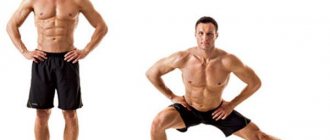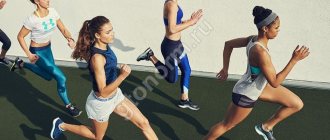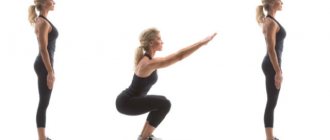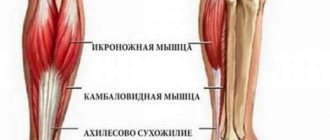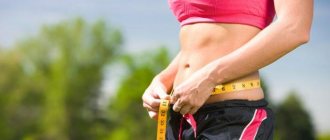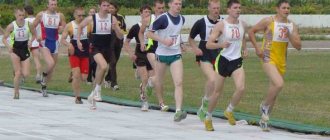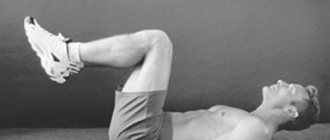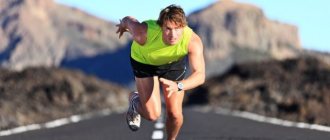A person often thinks about the limits of his own capabilities when he experiences physical, mental or psychological stress. Athletes who live by the motto “Faster! Higher! Stronger!”, they strive to surpass themselves and show their best results. Many athletes and active lifestyle enthusiasts are wondering how to increase their running speed. In fact, this requires 2 things - readiness for systematic training and a specific motivating goal.
Interval training
High intensity interval training is a great way to improve your speed and build confidence. Do speed reps once a week. For example, on a treadmill, you can run several 200-meter or 400-meter sprints with short intervals between sets. The workout is pretty simple.
- After a 5-10 minute warm-up, alternate between a vigorous 200- or 400-meter run and an easy jog or walk of the same distance to recover.
- If you have chosen a distance of 200 meters, then start training with 6 repetitions, gradually increasing their number to 8-10. For 400-meter intervals, perform 2-3 repetitions, increasing their number to 5-6 times. Training is equally effective when running on a track, stadium or treadmill.
If you are running along the road, lampposts can serve as a guide. For example, run intensely between three pillars and then simply walk to the next pillar. Use this pattern until you have covered one kilometer.
What they write about on the Internet about running 3 km
Not understanding my downtime on one result, I resorted to the help of the Internet. There was more than enough information on this topic, but it felt as if these articles were written from the same template. All approaches to the 3 km run were described in the same way. And one got the impression that they were often described by people who either did not run for results, or who ran at all a couple of times, and then only during physical education at school. And most of the text was written to order on the article exchange, where any student or girl on maternity leave received an order on this topic as a freelancer.
I don’t want to offend anyone, since I still got the basis from these articles. And some bloggers described their results and techniques as very useful. By applying the techniques that I read, the result improved, but not much. Perhaps more time was needed.
Still inclined to think about shifting his paradigm. Very simple things that need to be felt once rather than heard a hundred times. And perhaps in their articles these people (precisely those who describe their experience in running) feel this and at the same time find it difficult to convey through text.
Increased stamina
If you want to increase your speed over one kilometer, you will have to run a much longer distance. Don’t force things and go long distances; gradually increase the distance while jogging.
- For example, now in one workout you run 2-3 kilometers, in a week you can cover about 10 kilometers, just add about 1 kilometer per week, until then you will not run 7-8 kilometers at a time. It turns out that you need to add only 10% to your weekly distance, gradually increasing the load and increasing endurance. This rate of increase in distance is also relevant when preparing for a marathon or half marathon.
Doing one long run per week will improve your cardiovascular fitness and strength, leading to faster running. You will also become more confident psychologically, and you will not feel discomfort in the last meters of the distance.
conclusions
In conclusion, we can say that the above methods for improving 3 km running results were achieved through trial and error. Practice, practice and more practice. We've set a goal, go ahead. Don't stop there, improve. Self-discipline is for great people, and you can, no, you should be one of them.
Addition: after several years of practice, I wrote a post “How to run 3 km in 12 minutes,” where I shared my personal experience about running. In it, I revised some of my positions regarding the approach to training.
I ask all runners to write their criticism in the comments. I also ask you to post your methods for developing endurance and speed, preferably for a 3 km running distance.
That's all, create yourself with CSelf.ru! Sincerely, Alexander Petrishchev!
Increased stride speed
The speed at which your feet touch the ground is called stride speed or stride revolution. You should try taking faster and shorter steps, this will definitely increase your speed.
Most new runners have a running speed that is too slow. Trainers sometimes recommend taking 180 steps per minute. But still, some scientists believe that the speed of steps is a purely individual indicator.
You can determine your current speed and improve it with the following exercises:
- Determine your current performance. While running, count how many times your right foot touches the ground in 1 minute;
- Double this number to get your turnover rate;
- Try to improve it with a running exercise.
Run in 1-minute intervals, starting at your usual pace. Then run again, but increase the count of kicks. Repeat the sequence several times, each time trying to increase the number of kicks by one.
If you have a heart rate monitor, you can monitor your pulse. You perform your most effective steps at your lowest heart rate.
Follow the correct running technique. Your feet should be placed under your hips, not in front of your body, when running.
Adviсe
- It is impossible to improve speed performance without the ability to overcome long distances. Therefore, you first need to train over long distances at your usual pace and gradually increase it.
- During doubles races and marathons, there is no point in matching other participants or trying to overtake them. This way you can get tired or get injured faster.
- There is no need to think about the correct technique while running - this will not help increase speed.
- Also, you should not try to artificially stretch your stride, otherwise you may damage the ligaments.
- You can train at any time in the morning or evening.
- It is not advisable to skip workouts. You need to exercise despite laziness or bad mood. But nevertheless, you should listen to yourself. Exercise will not be beneficial if the body is depleted by illness or the athlete has been subjected to emotional and mental overload. You need to learn to distinguish the reasons why you don’t want to go to training: perhaps this is a manifestation of laziness or inertia, or the body is saving energy for recovery.
- Whenever possible, races should be held outdoors.
- In everyday life and in training, it is recommended to practice brisk walking in a relaxed state. This will help your muscles get rid of tightness during the marathon.
- A person will run faster if he marks a specific goal on the horizon. Then the distance to the object will visually appear shorter. In addition, the athlete will not look at the floor, but straight ahead, which will help him maintain his posture.
- To avoid thirst and dry mouth, you need to drink a glass of clean water half an hour before the race.
- But eating before the sprint is prohibited. You can have a light snack an hour before, but not later.
- You should take care of comfortable shoes. Sneakers should have a soft grooved surface and fit perfectly on the foot. It is better not to wear sneakers, because they do not protect the foot from impact.
- During training, it is good to run to music. You can create your own playlist that will help you maintain a fast pace for quite a long time.
- Intense and sweeping movements of the arms contribute to acceleration and development of acceleration.
- During a marathon, it is easier to count not the distance, but the objects that come along the way. You need to focus on external objects, and not on how fast a person is moving or how many meters are left to the finish line.
- Mental overload takes away strength, so before the race it is better to get a good night's sleep and watch some light comedy. In general, do only what brings pleasure and promotes nervous relaxation.
All tips for increasing running speed are secondary. The most important thing is to train hard and work on yourself.
Previous article: Interval running: how to build an effective weight loss program Next article: Relay running
Improving your running technique
- At the beginning of each workout, take a few minutes to practice proper running technique. You can use simple warm-up exercises that will work on different aspects of good running form. This will ensure that your movements are enhanced while you run.
- Try adding four to six exercises to your warm-up that will improve your running form.
- For example, changing your stride quickly and efficiently helps you run faster with less energy. The fast legs exercise helps train your legs to move faster. Just run in place as quickly as possible for 1-2 minutes. Also perform kicks (raising your heels behind you toward your butt) to improve hamstring engagement.
After warming up and while running, pay attention to your posture, arm movement and leg position, as all these nuances directly affect your speed. Poorly executed movements will only waste your energy and slow you down. Work on your technique at a slower speed and you will definitely speed up later.
The Basics of 3K Running from My Own Experience
As I talked about in the previous article “How to record sports training” about the need to record your results for more effective training, this is perhaps the fundamental basis.
After running, goals appear for the result. Goals force you to improve. If you haven't gotten to this point yet... it's just a matter of time. Now you will most likely not take this fact as seriously as your breathing work, exercises and running technique, but I assure you that you will get a much greater surge of energy and motivation. And without motivation, not a single exercise or technique will affect the result.
Running on uneven surfaces
Running uphill helps improve performance by increasing your lactate threshold and reducing your running time. You can run on uneven terrain or use a special mode on the treadmill. But, unfortunately, on a treadmill you will not be able to simulate running down a mountain, and this is a very important part of training.
- Before running on uneven terrain, jog for 10-15 minutes at an easy pace. Try to find a hill with a gradual slope that extends approximately 100-200 meters.
- Start your uphill run at 5K pace. You'll want to push yourself up the hill, but don't force the form, go gradually. At the top of the mountain, stop, take a short rest and jog down.
- The number of repetitions depends on your experience and level of training. Beginners should start with 1-2 repetitions, adding one additional repetition every week for 3-4 weeks. Experienced runners can start with 6 reps and add one each week, ending at 10 reps.
- After completing all the repetitions, you need to jog for 15 minutes at a slow pace.
By the way
In the era of advanced technologies, convenient and affordable heart rate monitors appear. With their help, you can track your heart rate while running, thereby keeping your pace within your capabilities. Next year I plan to purchase such a thing. Once I test it, I’ll definitely write a post on the topic of running with heart rate monitoring. (already bought, tested and wrote my review in the article here) Anyone who already uses this thing, please briefly describe the benefits in the comments.
Climbing stairs
If you don't have access to the mountains, use the stairs. Use the same approach as in the mountains.
- Find a multi-flight staircase
- Climb the stairs in 30 seconds, then go down to recover
- Repeat 5 times
- Gradually work your way up to 10 repetitions.
As your fitness level increases, try to run more stairs.
Factors affecting speed[edit | edit code]
Among the factors influencing sports performance, general and specific factors can be distinguished, whose effects can manifest themselves to varying degrees. Thus, Grosser and Renner (2007), along with anatomical and muscular-physiological ones, also cite innate abilities, developmental and learning characteristics, as well as cognitive and psychological factors. In this book, for the sake of brevity, only the main factors associated with the neuromuscular system and that can be directly influenced during training will be considered. At the same time, it is not excluded that training even influences, for example, the socialization of athletes involved in sports that develop speed (Grosser, Renner, 2007), although the connection of this phenomenon with the factors considered here may be indirect.
Based on the definition of speed (Zaciorskij, 1968), its relationship to movement in individual joints and the various forms of speed according to Grosser and Zintl (1991), various conditions for the development of speed and the possibilities of its training will be considered in the following. To do this, similar to what Schollhorn (2003) does, one should first consider anatomical and musculophysiological (see below), as well as physical and biomechanical factors (see section “Physicobiomechanical factors” below) and then describe the issues movement techniques.
Anatomical and muscular-physiological factors[edit | edit code]
If complex and fast motor actions are understood as a set of movements of individual joints, then from an anatomical and muscular-physiological point of view, for the development of movement speed, the main role is played by the distribution and recruitment of certain types of muscle fibers, the ratio of strength and length of the muscle, and the cycle of stretching and shortening.
Distribution and recruitment of muscle fibers[edit | edit code]
Muscle fibers of skeletal muscles are divided into so-called slow-twitch (type I) and fast-twitch fibers (type II).
Rice. 3.23. Distribution of muscle fibers types I and II in non-athletes and athletes
Type II muscle fibers are also divided into two categories. For rapid flexion and extension of the joint, the proportion of fast-twitch type II fibers plays an important role. This has been proven using muscle biopsies - studies have shown that athletes with developed endurance have a predominance of muscle fibers of this type, which are characterized by the ability to resist fatigue during prolonged exercise. In athletes involved in sports that develop speed, there is a predominance of type IIa and IIb muscle fibers, which are characterized by relatively rapid fatigue, but at the same time are capable of quickly developing great strength (de Marees, 1996). In Fig. Figure 3.23 schematically shows the proportion of muscle fibers of types I and II in various athletes. It must be emphasized that based on the type of muscle fiber alone, it is impossible to draw a conclusion about its ability to develop strength without taking into account other factors. Although there is evidence that type II muscle fibers have the ability to produce greater force, this ability is primarily dependent on cross-sectional area rather than muscle fiber type (Billeter and Hoppeler, 1992). Training methods for increasing muscle cross-sectional area are described in section. 3.2. In addition, it is necessary to consider the regulation of the strength of contractions in the muscles. According to Henneman's incremental principle, small motor units are initially recruited for muscle contractions and, depending on the degree of resistance, larger units are gradually added to them (Henneman, 1957; Henneman et al., 1974; Riidel, 1998).
It is interesting to note that smaller motor units are typically composed of type I fibers, while larger ones are composed of type II fibers (Hodson-Tole and Wakeling, 2008). Therefore, the increase in strength is accurate and uniform, however, if the speed must be high already at the moment the movement begins (for example, a sprint start), this model is not optimal. In this case, primary recruitment of type II fibers is more appropriate, since they are characterized by a higher rate of contraction and relaxation and a greater potential for force development (He et al., 2000). Primary recruitment of type II fibers is possible at high “firing rates” of motor neurons (see Fig. 3.15), or, as recent studies have shown, during the activation of so-called functional task groups (Hodson-Tole, Wakeling, 2008). This term refers to special groups of motor units that are characterized by a predominance of type II fibers and very rapid activation. Currently, there is also debate about the extent to which mechanical factors of movement, through sensory information, can change the order of muscle fiber recruitment according to Henneman's principle so that large motor units are recruited immediately at the beginning of movement. This model can be supported by practical findings from studies by Henneman and other authors. Their models were based on studies of the behavior of cats with crossed afferent pathways—in which case sensory information from muscle spindles, nerve endings in tendons, or joint receptors is not part of the regulation of movement (Windhorst, 2007).
The relationship between muscle strength and length[edit | edit code]
For rapid development of strength in a muscle, an optimal starting position is necessary (Herzog, Ait-Haddou, 2003). According to the “sliding filament” theory, strength in a muscle is developed by the interlocking of actin and myosin filaments, their subsequent sliding towards the center of the sarcomere and then returning to their original position (Riidel, 1998). The magnitude of the force depends on the number of cross bridges. Since the length of the sarcomere is proportional to the length of the muscle, if the sarcomere or muscle is too long, the force generated will be negligible. The same thing happens in a shortened muscle, since in this case the filaments prevent each other from moving.
In order to achieve a certain speed of movement, it is important that the initial conditions are optimal for muscle contraction. Since the origin of the muscle and the place of attachment to the bone are anatomically fixed, the muscle can shorten or lengthen only when the distance between these two points changes, which is possible only when performing movements or changing the position of the torso. Schollhorn (2003) describes this using the example of the ischiocrural muscles: if in a standing position the pelvis is deviated from the vertical axis, the distance between the beginning and end of the muscle increases, which leads to some preliminary stretching of the muscles, i.e., to a change in the original position. Below we will discuss other phenomena that are also caused by changes in muscle length.
Cycle of stretching and shortening[edit | edit code]
Another opportunity to increase the developed strength is to modify the motor parameters of the muscle. Typically, muscle length and its changes are regulated by muscle spindles in the intrafusal fibers of the muscle. These muscle spindles can record not only the change in muscle length, but also the rate of that change. If the muscle is stretched faster, then the muscle spindles send impulses to the motor neurons of the spinal cord in proportion to the degree and speed of stretching through fast-conducting afferent spindle 1a fibers. These motor neurons activate the stretched muscle and simultaneously inhibit the motor neurons of the antagonist muscles (Illert, 1998).
This length-stabilizing reflex performs, on the one hand, a protective function, protecting the muscle from damage at high stretch speeds; on the other hand, during the swing, the stretch reflex, thanks to the activation of motor neurons, provides preliminary muscle tension and a sufficiently high initial force necessary for subsequent (concentric) muscle activity (Komi, 2003; Hohmann et al., 2007). This effect is enhanced if the muscle is rapidly stretched in the direction opposite to its contraction (eccentrically): as can be seen in Fig. 3.24, in a muscle that contracts, leaving a state of rest, less force is generated than when this muscle is stretched in the opposite direction, and the development of muscle force also depends on the speed of stretching.
rice. 3.24 Dependence of force on speed
Eccentric contractions combined with concentric ones are called the stretch-shorten cycle (Komi, 2003). The significance of this cycle in sports activity is described by Schollhorn (2003) using the example of “drop-jumps”: when jumping down from a small height and then immediately rebounding upward from the landing point, the ankle joint first bends (landing) and then straightens (rebound). upward), with the calf muscles contracting first eccentrically (stretching during a tense state during landing), and then concentrically (shortening during an upward rebound). If the tips of the toes are lowered down before landing and then the toes are actively extended, then the calf muscles, due to a higher speed of contraction than in the passive state of the legs, will be under the influence of an eccentric load (see Fig. 3.24), which increases the force of subsequent contraction. In this case, muscle spindles, due to a higher rate of muscle stretching, “work” at a higher frequency (see above), which, in turn, leads to the fact that motor neurons in the spinal cord, due to a higher frequency of excitation, activate a large number of large motor units (Winter, 2005), which have the ability to develop greater force (see section 2.1.3). Scientists are currently debating how mechanical changes in the muscle membrane affect force generation. It is considered possible that as a result of rapid eccentric stretch and the associated mechanical change in length, the ion channels of the muscle membrane open quasi-passively, which causes an additional current of Ca2+ ions into the cell (Kistemaker et al., 2005). Calcium ions play the role of an intracellular signaling substance, the so-called messenger (Riiegg, 2000).
Physical and biomechanical factors[edit | edit code]
Rice.
3.25. Forces affecting movement Physico-biomechanical factors of speed play a particularly important role in complex movements. Muscles can flex and extend joints, but muscle actions are not sufficient to be called movements. As shown in Fig. 3.25, human movements depend not only on active (muscle strength), but also on passive forces (gravity, inertia).
Their importance for movements in general and for fast movements in particular should be shown by the example of the action of the lever rule and the conservation of rotational momentum.
Lever[edit | edit code]
Rice.
3.26. Pattern of movement of the “leg” lever as a result of contraction of the single-joint hip flexors The simplest example of a lever in the human body is the arms and legs, which from the point of view of physics can be considered as a single-arm lever and rotate freely around one axis (shoulder or hip joint). In order to set a lever in motion, as will be shown below in the example of a leg, the musculoskeletal system requires a muscle that will bring the lever into action at some point. When the muscle contracts, i.e., when it shortens, the lever is set in motion (provided there is sufficient contraction force) (Fig. 3.26).
Rice. 3.27. Change in muscle strength during the action of a lever as a result of a change in the position of the torso: a - straightened leg; b - bent leg
The speed of the lever movement depends on many factors. It was shown above how anatomical and musculophysiological factors play a role in a rapid contraction that can immediately generate greater force. Within one movement they remain unchanged. When considering changes in the speed of the lever, it is necessary to pay attention to the following factors (Fig. 3.27): the mass of the lever and the acceleration of gravity (together making up the force of gravity FG, which acts on the center of gravity of the lever), the distance of the point of application of the muscle force IM and the distance of the point of application of gravity from the axis of rotation IG (this is the center of gravity of the lever) (see formula in Fig. 3.27).
The force required by the muscle to operate the lever can be influenced by changing the position of the joint (here: knee joint) (Schollhorn, 2003). Also, when changing the position of the lever, muscle force can be used to develop a higher rotation speed in the joint.
Conservation of rotational momentum[edit | edit code]
Rice.
3.28. The principle of conservation of rotational momentum and its influence on movement in sports All human movements can be imagined as rotational actions of certain parts of the body around free axes. In this regard, the conservation of rotational momentum plays an important role: in a closed system, the rotational impulse does not change. The rotational impulse is calculated as the product of the moment of inertia and angular velocity. The moment of inertia, in turn, can be changed by reducing the distance between the rotating mass and the axis of rotation (the moment of inertia will then decrease) or increasing this distance (the moment of inertia will increase). In reality, this occurs during extension and flexion of joints or the entire torso. When performing a somersault, the rotational impulse is already set during the rebound and does not change further. Nevertheless, the athlete can, by changing the position of the body, influence the speed of rotation: when pulling the knees to the chest, the center of gravity of individual parts of the body approaches the axis of rotation, which reduces the moment of inertia and increases the speed of rotation. Similarly, when the knees flex during the swing phase, the rotation speed at the hip joint increases and the upward swing motion of the knee is thus faster (Fig. 3.28).
Sports equipment[edit | edit code]
Based on the fact that the speed indicator is based on anatomical, muscular-physiological and physical-biomechanical factors, the function of sports equipment is to perform movements that achieve the fastest possible change in position in the joints. This speeds up the overall execution of the movement. In this case, the coordination of individual movements can be neglected.
Motor coordination and its training are described in section. 3.4. This definition follows, on the one hand, from the muscular-physiological properties, and on the other, from the biomechanical properties of complex movements.
If an athlete needs to achieve high speed leg swings when sprinting, he must change his technique. For example, this is possible by extending the moment of push-off from behind during the support phase. As a result, after the foot leaves the ground:
- the thigh remains behind the back and thus provides preliminary stretching of the single-joint muscles that flex the hip joint;
- the lower leg moves upward by inertia, which provides preliminary stretching of the biarticular muscles that flex the hip joint; And
- Thanks to the impulses of the muscle spindles, a preliminary activation of the motor neurons occurs, so that as a result of the above-described preliminary stretching of the muscles that flex the hip joints, in combination with the lower legs moving upward by inertia (up to the touch of the heel to the buttocks), the swing movement becomes faster.
This technique has a further influence on the nature of the movement performed. Due to the higher angular velocity of the hip movement developed in this way, the antagonist muscles (the gluteal muscles and the muscles of the posterior group of the thigh) are stretched faster, which is reflected in a more active preliminary stretching of the muscles that extend the hip joints, and which, accordingly, increases the initial strength, necessary for subsequent extension of the hip joints (Schollhorn, 2003).
Sports technique combines both factors influencing the speed of movements and creates the possibility of its complex regulation.
It is interesting to note that this example shows that complex forms of speed can also be influenced by factors related to general physical fitness and coordination.
Losing excess weight
Losing a few pounds can cut your running speed by 20 seconds. But with active training and preparation for competitions, it is quite difficult to lose weight, because the body needs energy and you should not severely limit your diet. We recommend that you use the following recommendations when preparing your diet:
- Eliminate empty calorie foods. Sugary sodas, candy, fried snacks, and sugar-laden baked goods contain calories that are not good sources of nutrition.
- Eat foods rich in nutrients: vegetables, fruits and berries
- Choose meals based on lean protein, whole grains and leafy greens.
Also watch your portion sizes. You can eat a large lunch after your workout, but never eat more calories than you burned. To create an individual nutrition schedule, consult a nutritionist who will take into account the number of calories burned while running.
Plank with leg raises
The well-known plank exercise has several variations. One of which is a plank with alternating leg raises. The plank helps strengthen your back, abs, legs, obliques and hip joints. It is harder to hold planks on your elbows than on outstretched arms. This exercise is quite energy-intensive, but very effective. Start with 20-30 seconds and add a little each time. Unlike the classic plank, the plank with alternating leg raises is usually performed not for time, but for the number of lifts. The legs are positioned slightly wider than shoulder width. The leg should rise and fall slowly, the knee should be straight.
Increased Strength
Building muscle will increase your speed and bring other health benefits. You don't even have to go to the gym, just do the following exercises after your run:
- 10-15 push-ups
- 10 lunges forward and sideways
- 10 single leg squats on each leg
- 1 minute plank.
These basic exercises will help you strengthen the muscles that keep your body strong and stable.
Doing strength training after your running workout will help ensure you are fully rested on your recovery days.
How to run safer
Non-professional runners most often run at their natural cadence, which is different from their ideal cadence. However, some are more prone to injury, while others are less prone to injury. A pair of scientific papers examining the difference between the two were presented in June at the annual meeting of the American College of Sports Medicine.
In the first study, Erin Futrell, Adam Tenforde, Steve T. Jamison, Irene S. Davis. Relationships between natural cadence and vertical load rates in injured and healthy runners. 32 healthy and 93 injured runners took part. It showed that the average cadence of runners in both groups differed slightly: 164 and 161, respectively.
Scientists compared the load on the foot, and it was indeed higher in injured runners. However, no correlation of this parameter with the cadence of healthy and injured runners could be found.
In another study, Jacqueline Morgan, Robert L. Franco, Kate Harrison, Anson M. Blanks, Heather L. Caslin, DS Blaise Williams. Stride frequency and injury rates in recreational runners training for a half-marathon. 28 amateur runners participated who were preparing for the half marathon. In this case, there was a clear correlation between injury and cadence:
- 8 out of 12 runners with a cadence below 162 were injured - 67%;
- 5 out of 7 runners with a cadence of 163–168 were injured - 71%;
- Only 2 out of 9 runners with a cadence above 169 were injured - 22%.
It is worth noting that this study did not take into account the runners' initial training. During the study, the average cadence of all participants increased from 165 to 173 in preparation for the race. It is likely that runners with higher cadences were initially better prepared and therefore less prone to injury.
It turns out that the research data is mixed. Of course, this is not to say that cadence is not important for safe running. However, it makes no sense to rely only on this parameter: it is too early to name the ideal number.
At the same time, fewer contacts with the ground with longer steps also does not guarantee less load on the leg.
